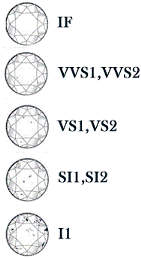The term clarity of a diamond refers to the size and the number of inclusions in the diamond. The inclusions are also referred to as inperfections of the diamond.
Tiny inperfections occur in almost all natural diamonds. These flaws are present due to the incredible amount of pressure during the formation of the diamond billions of years ago.

The two types of flaws in a diamond :
There are two types of flaws in a diamond, one is inclusions and the other is blemishes. Inclusions within the stone is referred to as internal flaws.
It is important to note that “all flaws are called inclusions”.Therefore inclusions also include flaws such as cracks, air bubbles and other non diamondminerals found in the diamond.
Types of Internal Flaws:
i) Dark Spot: These are small crystal inclusions or thin flat inclusions that reflects light just lika a mirror.
ii) Pinpoints: These are usually small whitish dots that are difficult to see. There could be numerous pinpoints( Cluster or clouds).
iii) Laser treatment: This occurs after laser is used to treat flaws and make them less visible.eg a black spot can be vaporized leaving a void in the damond.
iii) Colourless crystal: This is made up o a small crystal of diamond or another mineral.
iv) Feather: Another name for a crack. A small feather is not dangerous, especially if it does not open through a facet.
v) Cleavage: This refers to a crack that has a flat plane. this could cause the diamond to split if it is struck in a certaindirection.
vi) Knaat or twin lines: This refers to a slightly raised dot with a trail resembling a comet.
vii) Growth or Grain lines: Can only be seen while rotating the diamond slowly. They may appear and disappear instantaneously.
viii) Bearding ot Girdle fringes: This results from hastiness during the bruiting process- while giving the diamond its intial shape.
Types of External Flaws:
i) natural: Here the girdle looks lika a rough unpolished area. It is the natural remnant of the natural skin of the diamond. This also indicates shortage of rough as the cutter made the largest acceptable material from the diamond.
ii) Nick: A small chip on the girdle. It may also be seen on the edge of a facet. A nick can be caused by wear.
iii) Pits or Cavities: These are holes or pits on table facets.
iv) Abraded or Rough Culet: Here the culet has been chipped or finished poorly.
v) Polishing Lines: This affects many diamonds. It is due to badly maintained polishing wheels.
vi) Scratch: A scratch is a minor defect that can be removed by re-polishing.
Blemishes refers to pits, chips and scratches. However some blemishes may occur during the cutting process (Often at the girdle).
Large inclusions may interfere with the dispersion of light and affect the brilliance of the diamond, therefore the larger or more numerous the inclusions in the diamond the less valuable it becomes.
Grading of Diamonds for Clarity

The grading of diamonds for clarity is always done under X10 magnifying glass, also known as the ‘loupe’ or ‘jewelers loupe’.
i) F : Flawless, these diamonds do not have any internal or external flaws. These are extremely rare.
ii) IF : Internally Flawless, these diamonds do not have any internal flaws but have some blemishes on the surface. These are very rare.
iii) VVS1 and VVS2 (Two grades), these stand for Very Very Slightly Included 1 and 2. These refers to minute inclusions very difficult to detect under X10 magnification even by a trained gemologist.
iv) VS1 and VS2 (Two grades), these stand for Very Slightly Included 1 and 2. Here there are minute inclusions seen with difficulty under X10 magnification.
v) SI1 and SI2 (Two grades), these stand for Slightly Included 1 and 2. Here there are minute inclusions that are easily detectable with X10 magnification.
vi) I1, I2 and I3 (Three grades), these stand for Includes 1, 2 and 3. Here the inclusions are easily visible to the naked eye as well as under X10 magnification.
It is important to note that although the presence of inclusions lower the clarity grade and value of the diamond, they can be used as proof of the diamonds identity, eg. A GIA diamond certificate includes a ‘plot’ of the diamond’s inclusions.
My Recommendation:
The clarity grade of a diamond does not have an effect on the unmagnified appearance of the diamond, until you go down to Grade I.
VVS and VS diamonds are the best choices for both the value and appearance of a diamond.
Eye clean diamonds, such as SI1 and SI2 have no inclusions that are visible to the naked eye.Therefore they still look great while being more affordable.
You are welcome to discuss this post/related topics with Dr Shihaan and other experts from around the world in our FORUMS (forums.internetstones.com)
References;
